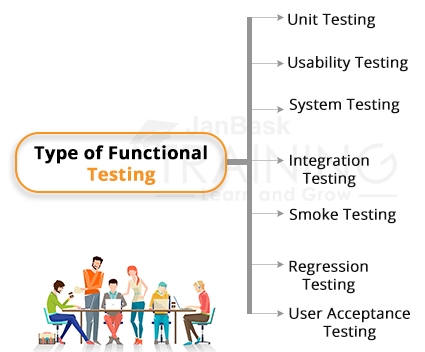 Grab Deal : Flat 30% off on live classes + 2 free self-paced courses - SCHEDULE CALL
Grab Deal : Flat 30% off on live classes + 2 free self-paced courses - SCHEDULE CALL

 Grab Deal : Flat 30% off on live classes + 2 free self-paced courses - SCHEDULE CALL
Grab Deal : Flat 30% off on live classes + 2 free self-paced courses - SCHEDULE CALL

Usability testing is a testing methodology in which the software or application is handed over to the user and he tests it by using it. The customer is asked to check that whether the system is as per his requirement or not. The best way to test or check the software or application usability is to provide him the prototype of the software even in initial stages and ask them to test that whether it is as per their requirement or not.
Testing is a quite popular and promising carer option these days and if you also want to kick-start your career as software testing professional. Then you can go for Usability Testing domain. Here in this post, we are going to discuss the commonly asked questions for this profile to fresher and experienced professionals.
Usability testing is associated with testing of software usability. Usability testing is a testing methodology in which the customer is asked to test the usability of the software. It can be performed either by providing software prototype to the customer and ask them to test its various features and functions. Like if it is a login module then the user will check that whether there is forgot password link available or not.
Functional testing is just a black box testing in which the application functionality is tested and the certain input is provided to test whether the desired output is being generated or not. Through such testing, not only the application behavior is tested but it will also check either the application is as per user requirements or not. Moreover, it is also tested that whether the application can be released to live environment or not?
Functional testing can be of the following types:

While conducting usability testing, below listed steps must be covered as part of testing:
Build and release are two separate terms that are associated with the software. These terms can be defined as below:
Build: Software build is an executable file that is basically handed over to the tester by the development team. Through this executable file, the tester can test the implemented functionality of the application for any bug or fixes. If the software build does not pass the critical checklist that has the major part of application functionality then it can be rejected by the testing team.
As far as software release is concerned, this is the stage when the software application is no longer in the testing phase, then it is named as release cycle. A software release can have more than one build. When the application is handed over to the user after completion of development and testing then it is called the software release.
Bugs are the errors that are found in the software application. They can be in various states and of many types.
Main types of software bugs are listed below:

When a series of test cases are executed repeatedly like XML file, SQL database or CSV file then it is called data-driven testing. The output or actual values are compared with the expected ones to verify the result. Yes, because in the case of usability testing we need to work on data to check website behavior, brand perception, validate data etc.
It offers the following advantages:

Most important activity and part of the test execution process is to write the proper test cases, it requires complete knowledge of the application and good writing skills. The Tester can consider below-listed points while writing usability test cases:
When automatic tools are used to execute the test case suite just to increase test coverage and speed up test execution, then it is known as Automation testing. No human intervention is required in automation testing, as pre-scripted test cases are used to compare the outcomes of previous test cases. Yes, we can automate the usability testing with the help of test cases that can be executed repeatedly to check the product behavior.
Automation testing is advantageous as it offers accuracy, ease of use and great consistency. Some of the popular tools of automation testing are:

These are two functional testing that can be defined as:
Stress Testing: It is a performance testing, where the application is tested for stress or execution that means that it is tested above the threshold of the break and the point where the application gets broken is determined. When there are huge data and the number of users then it can arise. During the stress test, the application recovery time is also determined when the load gets reduced.
Load Testing is also a type of performance testing, in this testing, the application is executed above various levels of load and the peak performance of the application is monitored on the server along with server throughput, response time, etc. Application integrity, performance and process stability are determined under concurrent system load in this testing.
Volume testing is also a type of performance testing in which server throughput and response time is determined when concurrent users are there and data load is large from the database, and the application is put under tests.
Below listed two types of usability testing is used in testing:
Well, it is highly important for websites because it checks the complete behavior and validates the input and the output. It will check either the home page is working as per the expectations or not. If there is something missing then it is immediately informed to the website developers.
It gives compelling evidence of which elements are working perfectly on your website what needs to be fixed. Also, it will provide a compelling optimization strategy to make sure that everything is in place.
Database Testing Interview Questions
Usability Testing Interview Questions
Security Testing Interview Questions
Regression Testing Interview Questions
Performance Testing Interview Questions
ETL Testing Interview Questions
Automation Testing Interview Questions
Manual Testing Interview Questions
QA Testing Interview Questions
Manual Testing vs. Automation Testing
Usability testing is a part of functional testing and after testing the software for the functionality you can hand over it to the user and ask them to test for the expected result. If it is proven completely useful for the user then it is known as a flawless software. This is clear from the discussion that usability testing offers meaningful insights that are worth its weight in platinum. All the best for your next interview with this definitive guide to usability testing interview questions and answer!

Master Your QA Interview: Top QA Interview Questions & Answers

Top API Testing Interview Questions and Answers

Top Performance Testing Interview Questions

Top QTP Interview Question and Answers

Cyber Security

QA

Salesforce

Business Analyst

MS SQL Server

Data Science

DevOps

Hadoop

Python

Artificial Intelligence

Machine Learning

Tableau
Download Syllabus
Get Complete Course Syllabus
Enroll For Demo Class
It will take less than a minute
Tutorials
Interviews
You must be logged in to post a comment